Studying the anatomy of a goldfish may help you to better understand their behaviour and lifestyle.
Why do they do the things they do, how do their bodies work and what are all the correct names for the different parts of a fish? We aim to answer these questions in this guide.
Key Takeaways:
- Goldfish Anatomy: Goldfish have a complex internal and external anatomy, which affects their behavior and lifestyle.
- Domestication: Goldfish were domesticated from Prussian carp over 1,000–2,000 years ago and initially bred for food before becoming ornamental pets.
- Internal Anatomy: Goldfish lack a stomach and rely on gut bacteria for digestion. Their heart is two-chambered, and they breathe through gills by pulling water through their mouths.
- Cold-Blooded Nature: Goldfish are cold-blooded and depend on their environment to regulate their body temperature.
- Swim Bladder: The swim bladder helps control buoyancy, and damage to it can cause swim bladder disease.
- Goldfish Behavior: They rely on their lateral line for detecting water movement, vibrations, and energy signals. Their eyesight is advanced, including the ability to see UV and infrared light.
- External Features: Goldfish have cycloid scales for protection and agility, and their fins are specialized for various functions, including movement and spawning.
- Goldfish Fins: They have pectoral, pelvic, anal, dorsal, and caudal fins, each serving specific roles like turning, stopping, and propulsion.

History of the goldfish
In latin, the proper name for the goldfish is Carassius Auratus.
Goldfish are part of the order Cyprinidae, which is the largest order of fishes, including around 3,000 separate species from, Barbs to Danios, to Redtail Sharks, Rasbora and Carp.
Carp have been around a long time, and have an evolutionary history that could date back to around 23 million years ago, perhaps even longer!
Carassius is the genus of carp which goldfish belong to, it also includes some other carp species which look very similar to goldfish, known as Crucian Carps.
The genus is a more narrowed down grouping of carp, and helps biologists better categorise species, which are more closely related to each other.
And finally, Auratus is the species, including all the many different shapes, sizes and colours goldfish have been bred into, from Shubunkin to Ryuken, all the 200+ man made breeds are all the same species of fish, and can all interbreed.
Goldfish Domestication
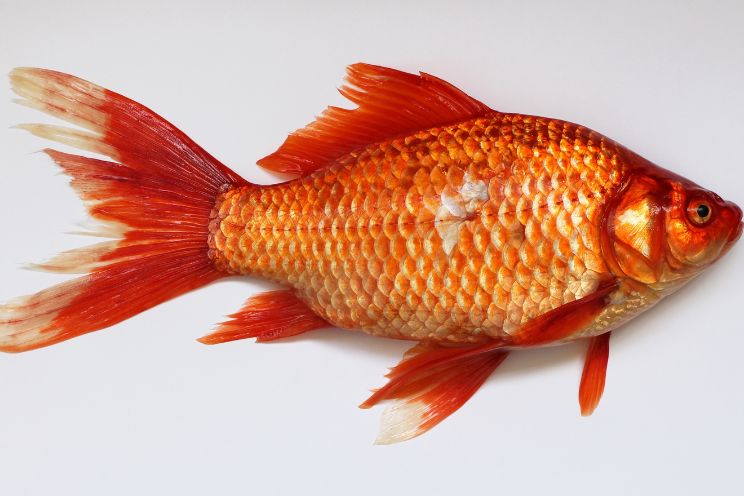
Goldfish have a long history of domestication – they were originally bred in Southern China around 1,000 – 2,000 years ago and their closest living relative is the Prussian Carp, which is likely what they were bred from.
The fish were originally bred for food, as they grew fast, bred in the thousands and were easy to tame.
Eventually, the fish were selectively bred for colours and were used in ornamental ponds.
The fish were displayed in fountains and water features all throughout China.
Eventually, the fish became a symbol of wealth.
Back then, the classic orange goldfish we are used to seeing today was only kept by peasants.
The true “goldfish” was actually the Canary Comet and was bright yellow – this fish was kept solely by royals and wealthy people in and around 16th century China.
Soon after its domestication, goldfish were traded to Japan, where they were bred into fancy breeds and the Shubunkin was created.
In the late 17th century, goldfish were then traded to the western world and have been a staple ornamental fish since.
In the west however, the perception of goldfish keeping has been warped, as when travellers originally visited China and saw the fish, they were displayed in glass or pot bowls.
This trend was not the norm in China at the time and it was unlikely the fish would spend its whole life within the bowl.
However, this trend was brought back to the west and replicated, thus comes the misconception that goldfish can be kept alive in glass bowls (they cannot).
In modern times, this trend has actually found its way back to China, and goldfish are now kept in bowls permanently there sometimes too.
All because of a simple misunderstanding.
If you need to know why keeping goldfish in a glass bowl can not be done, we have a full guide on why.
Today, goldfish are perhaps the most studied and widely kept species of fish worldwide!
They are amazing creatures that have a long history with mankind and play an integral part of many east asian cultures, folklore and religions, along with the Koi carp.

Internal anatomy of a goldfish
Goldfish have a fairly complex anatomy. While we may not be able to cover all the internal organs goldfish possess, we will go over the main stand out parts which make their anatomy unique and contribute to their different lifestyle.
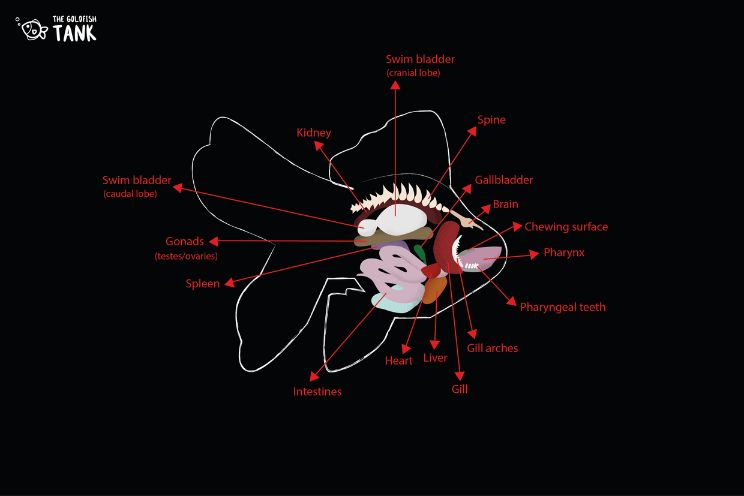
Do goldfish have a stomach?
As you may or may not know, goldfish in fact don’t have an acidic stomach like we do and instead, their whole digestive system is comprised of just intestines.
This means that goldfish rely entirely on the bacteria in their gut to extract nutrients from their food. This is why goldfish do not eat in temperatures below 4C or 39F, as below these temperatures, the bacteria go completely dormant.
Having to rely on gut bacteria is also why antibiotics are so devastating to goldfish, because it wipes out their only means of absorbing nutrients.
This is why we say to only use antibiotics and treatments when absolutely 100% necessary.
One of the largest killers of fish is not actually the disease themselves, it is people who treat misdiagnosed fish with the wrong chemicals.
Playing doctor for a fish that does not need treatment is the fastest way to kill them.
Are goldfish cold blooded?
Yes, goldfish are cold blooded – their blood is made from a different protein than ours, and so they rely on their environment to control their body temperature.
Fish however, are the best animals at absorbing heat from their environment, and some species of fish have a body temperature which is actually higher than that of the water around them.
They achieve this through their skin, as it is coated with scales and a slime coating, which traps heat effectively. Some fish are better at doing this than others however, as some fish are not as tolerable to temperature fluctuations.
All fish have a metabolism which is determined by the temperature of the water. A fish that lives in cold water will have a slow metabolism, it will burn less energy, eat less and be more docile.
Fish which are too cold, will enter a dormant state called torpor, where they expend very little energy at all, just enough to stay alive, they will not eat at all and will not move much during this stage.
A fish in warm water will have a faster metabolism, they will eat more, grow faster, move around more and lead a more energy intensive life, their lifespan will also be much faster in higher temps.
What is a swim bladder?
The swim bladder is an organ adopted by many fish – it is thought to have once been a primitive lung, which has been adapted for another use; to control buoyancy.
Imagine it like a small balloon, which the fish can inflate and deflate with pressurised gas to make the fish float or sink.
Some fish like sharks, skates, rays and many other bottom dwelling or deep sea fish, do not have this organ, or the organ is a different shape, and they must put in lots more effort to ascend in the water.
Or, they use other means of buoyancy control, such as having oils and fats in their body, that weigh less than seawater.
Some even swallow air to make this easier, but it means they cannot swim in open water for long periods of time, and must rest on the floor often.
You may have heard of swim bladder in another sense, in that it is disease, while this is a simple way to understand why your fish is swimming upside down, the description of it as a disease isn’t exactly accurate.
When a fish has “swim bladder disease”, it means that in some way its swim bladder organ has been damaged. This could be caused by many things; it could be infection, it could be punctured or physically damaged, it could be filled with gas or it could be compressed, etc.
Do goldfish have hearts?
Yes, Goldfish do have hearts, but they are not the same as our four chambered mammalian hearts – they are more primitive and consist of an elongated tube shape, which expands and contracts to pump blood around the body.
- All fish have a two chambered heart.
The mammal heart has four chambers, as it better separates exhausted de-oxygenated blood from oxygenated blood to feed to organs around the body. This makes the mammals heart and respiration system very efficient, and allows us to live an energy intensive lifestyle.
We are able to better extract oxygen from our environment, much better than say a lizard, which only has 3 chambers in its heart.
But how do fish even survive with only two chambers?
Fish are in fact excellent at consuming oxygen, so good that many species have specific traits which allow them to survive in very low oxygen environments for some time.
This is because fish are aquatic and they use gills to breathe, which is much different to breathing in and out through a pair of lungs.
How do goldfish breathe through their gills?
Goldfish breathe in quite a simple, yet ingeniously effective way.
Fish have multiple parts to their gills, which play different roles in the act of breathing.
The first most visible of these are the gill plates or “operculum” on the sides of the fish’s face. These structures are hard, flat flesh which work like a hydrofoil, to pull water past the gills.
- First, a fish will open its mouth and lift its operculum to generate a suction of water. The water would pull in through its mouth and into its gill compartment.
- Here are a series of thin, fleshy filaments, which absorb oxygen from the water passing over them. (They look kind of like tiny pink worms!) This oxygen is then diffused into the bloodstream and passed around the fish’s body.
- The blood then moves back to the gills and the deoxygenated blood is then reoxygenated with each breath the fish takes.
- The fish then closes its operculum to push out the now carbon dioxide rich water, and opens it again to pull in more oxygen rich water.
The fish does not pull the water into an aquatic set of lungs and then breathe it out, it simply draws water over a sheet of oxygen leeching filaments.
Do goldfish have a spine?
Yes, fish were amongst the first creatures to develop an internal backbone and we have them to thank for our spines and central nervous system today!
Goldfish actually have a skeleton similar to us, although it is less developed. It includes:
– A Spine;
– A Skull;
– Ribs;
… and is made from the same stuff our bones are made from (calcium carbonate and calcium phosphate).
However, fish do not have bones as dense as us, which allows them to be lighter in the water and more flexible, perfectly designed for their lifestyle.

External anatomy of a goldfish
External means the outside of the goldfish, the parts of the body you can see – this includes things like the eyes, gills, mouth, lateral line, scales and fins.
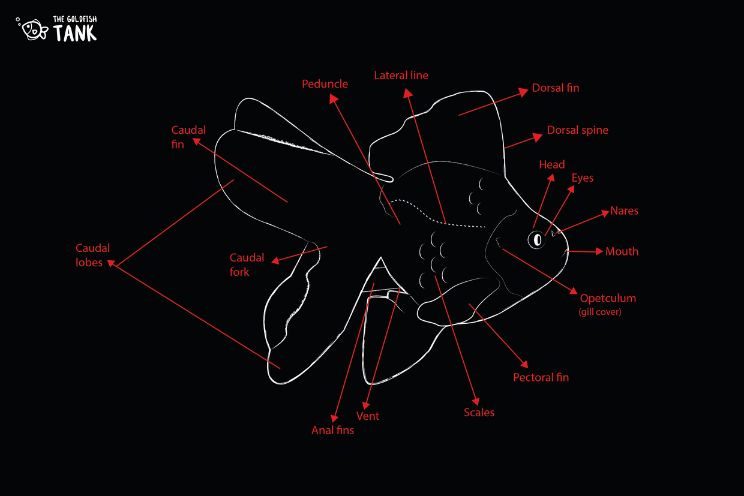
Goldfish Fins
All fish have multiple different types of fins across their bodies for different functions.
These fins are usually all the same and have evolved from one ancestor which had a basic design on these fins.
Some fish however, have specialised adapted these fins to all different exaggerated shapes and sizes.
Goldfish have a fairly standard arrangement of these fins, one which is adopted in a very similar way across most fish species.
The arrangement of fins is as follows:
The pectoral fins
The first two fins on the fish’s front, placed on the upper body, closest to the head.
These fins are primarily used for stopping or slowing down in the water, generating lift when near the ground, or turning.
Goldfish and carp in particular, also use their pectoral fins to blow on surfaces to reveal tiny animals and food, which may be buried in the substrate.
Pelvic fins
These are another pair of fins, but are located on the underside of the goldfish, near the tail.
These fins are also used as breaks as well as to rotate the fish and turn.
The pelvic fins are used to guide the fish in certain directions and maintain balance.
They are also used in spawning to assist the release of eggs and milt.
Anal fin
This is just one fin on the underside of the fish, just near the anus, this fin is used as balance, turning and stopping.
Much like the pelvic fins, it is also used in spawning to guide eggs and spawn.
Dorsal fin
This is the large fin on top of the fish’s back, it again is used to stop dead in the water.
This fin is also used to accelerate and decelerate when travelling at high speeds, and it is used to rotate the fished body up and down.
The dorsal also helps to control a fish’s buoyancy in the water and helps them move upwards.
Caudal fin
This is the tail fin of the fish, it is used for propulsion, fast movement and turning. It is the largest set of fins on a goldfish and the most powerful.
It is connected to the rest of the body by what is known as the “peduncle” , the slim bridge between the fin membrane and the central body.
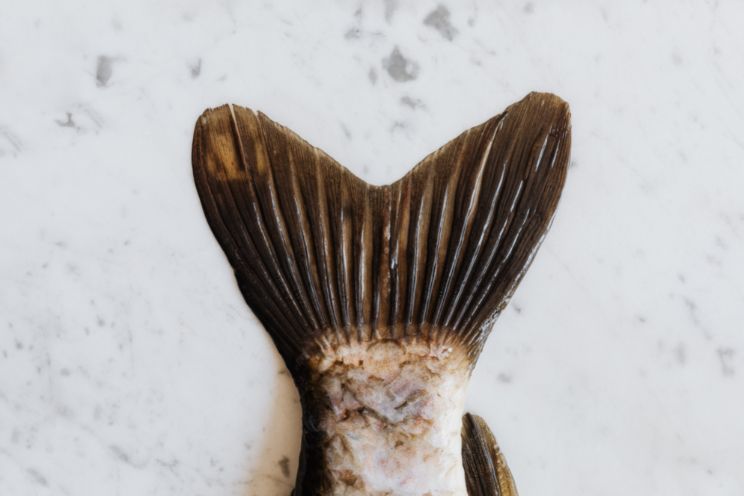
How many tail fins do goldfish have?
Goldfish typically have one tail, however, many breeds of goldfish have aimed to produce the “fantail” – this is based off of a deformity, where the goldfish grows two tails instead of one, but the tails are fused at the top.
This genetic deformity is seen as aesthetically pleasing to many goldfish breeders, and has been selected into many different types of goldfish.
It has become a staple of the fancy goldfish breed.
Although it may look nice, this type of tail actually impedes the fish, as its ability to swim effectively is reduced, and the fish has to put in more effort to move.

Do goldfish have noses?
Yes, goldfish do have noses and most fish actually have an excellent sense of smell!
You can actually see a goldfish’s nose, it is composed of two tiny holes on the front of their face, above their mouth, with two protruding flaps that stick out.
Their nose works by funnelling water over an olfactory organ – this detects chemical signatures in the water, and depending on the intensity, the fish can gather what direction the smell is coming from.
Very similar to our mammal nose, but more adapted for underwater.
How good is the eyesight of a goldfish?
Fish have amazing eyesight, it is among some of the best in the animal kingdom, and they can see many different waves of light that we cannot perceive with the naked eye.
Goldfish in particular can see in:
- Ultraviolet;
- Infrared;
- Depolarized light;
- and a few other forms of light.
They may not be able to see in incredible detail on a still object like we can, but they can spot tiny moving objects from up close and distance much better than we can.
- They can see in the dark pretty well and see through murky waters.
Overall, It’s safe to say that a goldfish has much more developed eyesight than us.
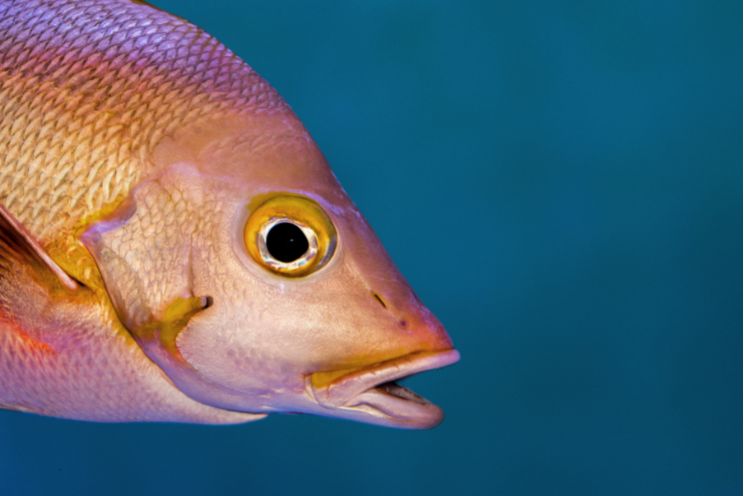
What is the lateral line in fish?
The lateral line is a highly developed sensory organ that nearly all fish possess; it is spread across the sides of the fish, and presents itself as a series of tiny dots along a line.
Each of these tiny dots are actually complex sensory structures, the line is made up of pours, water passes through these pours, and over a series of tiny pits.
These pits have a hair sticking from the top which can detect water movement, changes in current and pressure, vibrations and even energy signals left behind by other animals.
Fish need this lateral line to understand what is happening around them, without it, they would swim aimlessly and would not be able to sense oncoming danger.
What types of scales do goldfish have?
Different fish have different types of scales that are useful for different things.
Each fish has different scale structures based on its lifestyle, some are small and good for speed, some are heavy and tough like armour, and some are disease preventative.
There are four main types of fish scales:
Cycloid – these are the most common type of scale, found on most boney fish.
Ganoid – these scales are found on bichirs, sturgeon and gars.
Placoid – these are found on sharks and rays.
Cosmoid – these are rare in living fish and mostly consists of extinct fish species.
The scales that goldfish are covered in are cycloid – these are the most common type of scale, they form in an overlapping pattern across the whole body, provide protection and are streamlined for speed and agility.
Cycloid scales are also very flexible, which allows the fish to turn easily.
The scales often have tiny rudders at the base to help expel water past them, increasing manoeuvrability in the water.
FAQs:
- What is the history of goldfish domestication?
Goldfish were domesticated from the Prussian carp around 1,000–2,000 years ago in China and initially bred for food. - Do goldfish have a stomach?
No, goldfish lack a stomach and rely on bacteria in their gut to digest food. - Are goldfish cold-blooded?
Yes, goldfish are cold-blooded and rely on their environment to regulate their body temperature. - What is a swim bladder?
The swim bladder helps goldfish maintain buoyancy. If damaged, it can lead to swim bladder disease. - How do goldfish breathe?
Goldfish breathe through their gills, absorbing oxygen from water passing over them. - Do goldfish have a heart?
Yes, goldfish have a two-chambered heart, unlike humans, who have a four-chambered heart. - How do goldfish see in the dark?
Goldfish have excellent eyesight and can see in low-light conditions and murky waters, but they cannot see in complete darkness. - What type of scales do goldfish have?
Goldfish have cycloid scales that provide protection and enhance agility. - Do goldfish have noses?
Yes, goldfish have noses that help them sense chemical signatures in the water.